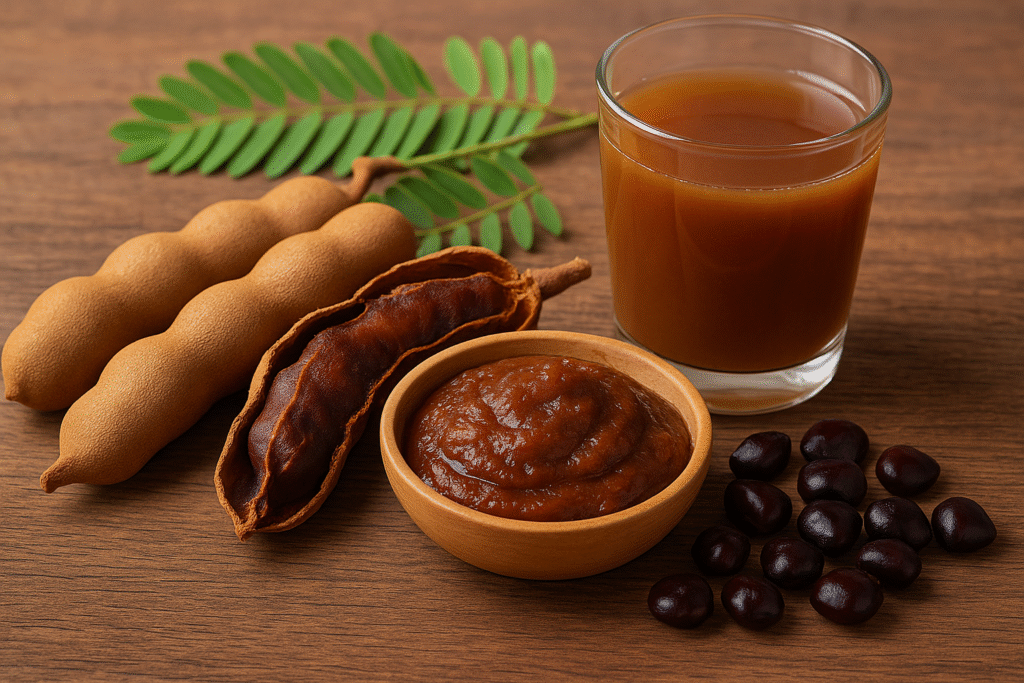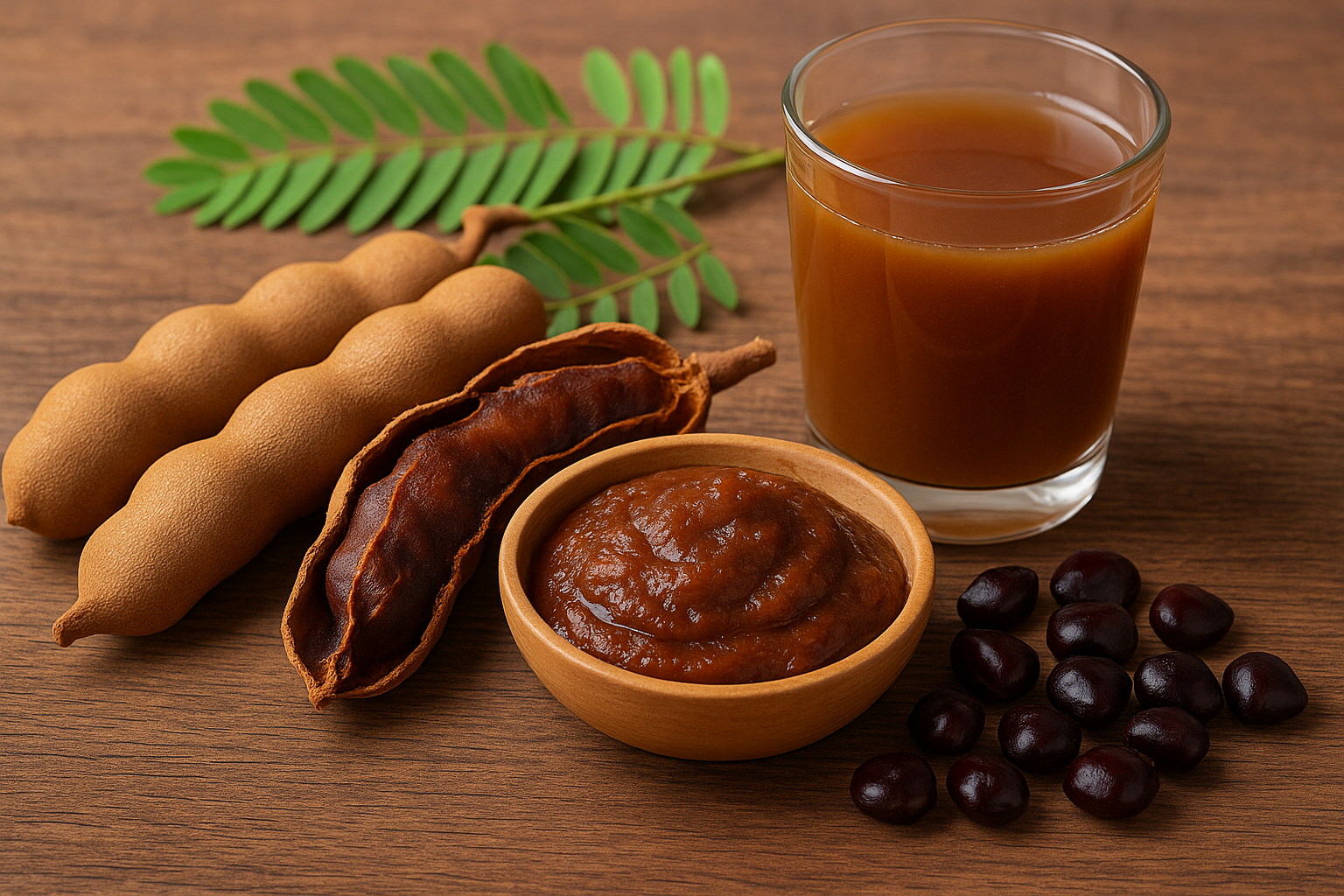
Tamarind Amazing 10 Benefits: A Tangy Superfood for Health, Skin, and More
Tamarind (Tamarindus indica L.) is a tropical fruit tree from the Leguminosae (Fabaceae) family, widely grown across India and many tropical countries. With its unique sweet-and-sour flavour, tamarind has been a culinary favourite for centuries. But it’s not just a kitchen essential — it’s a nutrient-rich powerhouse with potential benefits for the heart, digestion, liver, immunity, skin, and even hair.
Tamarind is a multipurpose plant — every part of the tree, from pulp to bark, has a use.
- Cooking uses: The main use of tamarind is in sauces, chutneys, curries, marinades, beverages, and sweet dishes. It’s even part of the famous Worcestershire sauce.
- Industrial uses: Tamarind finds applications in the pharmaceutical, textile, and chemical industries.
- Nutritional profile: This tangy pulp is a source of dietary fiber and essential vitamins and minerals — notably potassium, iron, magnesium, vitamin C, and B vitamins. It also contains powerful antioxidants such as flavonoids and carotenoids, which protect the body from oxidative stress.
Traditionally, tamarind drinks were used to treat diarrhea, constipation, fever, and malaria, while bark and leaves were applied to promote wound healing.
Health Benefits of Tamarind
1. Supports Heart Health
Many heart conditions begin with atherosclerosis, where fats and cholesterol collect inside arteries and restrict blood flow.
Tamarind may help:
- Lower bad cholesterol (LDL) and triglycerides
- Boost good cholesterol (HDL)
- Regulates blood pressure due to its potassium content
2. May Help with Iron Deficiency Anaemia
Iron deficiency anaemia is common, especially among women. Tamarind contains vitamin C, which enhances the body’s ability to absorb iron from food. In Ayurveda, tamarind is sometimes used as a blood tonic to improve red blood cell formation.
Note: Always seek professional medical guidance for proper diagnosis and treatment if you have anaemia.
3. Aids Digestion and Liver Health
Tamarind has been used as a natural digestive aid.
- Its mild laxative effect can relieve constipation.
- It may soothe diarrhea by relaxing intestinal muscles.
- Tamarind seeds are packed with antioxidants that could protect against stomach ulcers.
Research suggests tamarind leaves may have liver-protective effects.
4. May Offer Anti-Cancer Potential
Oxidative stress is a main factor in cancer development. Tamarind’s rich antioxidant content may help combat this. Early lab studies on tamarind seed extract indicate potential anti-cancer properties, but more human research is needed.
5. Diabetes-Friendly Properties
Tamarind seed extract may:
- Help regulate blood sugar levels
- Protect the pancreas from damage
- Reduce inflammation in tissues
6. Benefits for Skin
Tamarind’s natural acids and antioxidants may:
- Help in the treatment of boils, rashes, and skin infections
- Support wound healing
- Protect against sun damage
Its extract used in some sun creams for UV protection and immune support.
7. Pregnancy Nutrition
Pregnant women can benefit from tamarind’s:
- Iron and folate, which are vital for fetal growth and preventing birth defects
- Soothing properties that may reduce nausea and morning sickness
However, overconsumption during pregnancy can lead to excess acidity, so moderation is key. Always consult your doctor before adding tamarind to your pregnancy diet.
8. Hair Health
Tamarind’s vitamins and minerals can help:
- Nourish the scalp
- Reduce dandruff
- Promote stronger, shinier hair
9. Sexual Wellness
While not a direct aphrodisiac, tamarind’s nutrient-rich profile can improve overall vitality, indirectly supporting sexual health and stamina.
10. Boosts Immunity
Tamarind is full of vitamin C, carotenoids, and flavonoids. All these play a role in strengthening the immune system and protecting the body from infections.
How to Use Tamarind
- Cooking: Add pulp to curries, soups, and sauces.
- Beverages: Tamarind juice or sherbet is refreshing and nutritious.
- Snacking: Try tangy dried tamarind seasoned with a pinch of salt and a dash of chili powder for a flavorful treat.
Conclusion
Tamarind is a versatile fruit with potential advantages for heart health, digestion, skin care, immune function, and more. It has held an important place in traditional remedies for generations, and modern studies are beginning to shed light on its therapeutic potential.
Many of these benefits still require stronger scientific confirmation. Before using tamarind as a health supplement — especially if you’re pregnant, have an existing health condition, or are on prescribed medication — it’s best to seek professional medical guidance.
